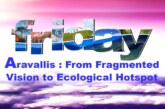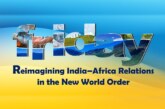
Dr. Arvind Kumar*
In light of this accelerating crisis, global attention turned to COP15 of the Ramsar Convention, held recently at Victoria Falls, Zimbabwe. More than just another diplomatic gathering, this milestone event served as a turning point an urgent call to shape the next decade of bold, coordinated action to protect one of the planet’s most threatened ecosystems under the theme “Protecting Wetlands for Our Common Future,”
The Kunming-Montreal Global Biodiversity Framework has provided a clear and urgent mandate: to collaborate across conventions, sectors, and borders. It calls for aligning strategies, integrating regulatory mechanisms, and embedding wetland conservation into national development plans—transforming synergy in action from a mere aspiration into a tangible reality. Yet, despite the strength of this mandate, the critical question remains: how much of this commitment is truly being implemented, and to what extent are countries aligning their actions with the framework’s intent?
Everything in the world springs from water, from birds and fish to animals, plants and people alike. As climate change accelerates, the vital role of water becomes ever more urgent: healthy water cycles are the backbone of nature’s resilience, while biodiversity the incredible variety of life that thrives in and around wet landscapes is its lifeline. Wetlands, the unique ecosystems where water saturates the soil, create extraordinary habitats ranging from marshes and swamps to mangroves and peat bogs. Though they cover only about 6% of the Earth’s land surface, they support an astonishing 40% of all plant and animal species and store 30% of all land-based carbon, double the amount stored in all the world’s forests combined. These ecosystems sustain over four billion people, especially the most vulnerable, providing livelihoods through agriculture, fisheries, and tourism, while delivering indispensable services like water purification, flood control, and groundwater replenishment. The economic value of these services alone is estimated at an astounding US$47.4 trillion annually.
Can we afford to overlook these silent guardians of our planet?
What is at stake if wetlands continue to disappear beneath the pressures of human activity and climate shifts?
Nature Positive or Net Loss?
Wetlands are far more than picturesque landscapes they are powerful ecosystems whose benefits ripple across nearly every Sustainable Development Goal (SDG). From purifying water and storing carbon to buffering floods, supporting food and health systems, and enhancing climate resilience, wetlands are fundamental to a sustainable, net-zero future. Yet today, they stand at the epicenter of the triple planetary crisis: climate change, biodiversity loss, and pollution. According to the Global Wetland Outlook 2025, the world has already lost 22% of its wetlands since 1970 an area equivalent to more than half a billion football pitches. With a continuing loss rate of approximately 0.52% per year, we risk losing an additional 20% by 2050. Such a trajectory could deprive humanity of an estimated $39 trillion in annual ecosystem services. Degradation of such ecosystems directly undermines climate resilience and accelerates the collapse of freshwater biodiversity. Alarming evidence from WWF’s Living Planet Report reveals that 83% of freshwater-dependent wildlife populations have vanished since 1970.
In light of this accelerating crisis, global attention turned to COP15 of the Ramsar Convention, held recently at Victoria Falls, Zimbabwe. More than just another diplomatic gathering, this milestone event served as a turning point an urgent call to shape the next decade of bold, coordinated action to protect one of the planet’s most threatened ecosystems under the theme “Protecting Wetlands for Our Common Future,” It marked as a decisive moment with the adoption of the landmark Victoria Falls Declaration underscoring the urgent need for stronger political will, increased resource mobilization, and focused investments in wetland restoration and protection. Demonstrating broad international consensus, participants unanimously approved all 13 resolutions presented, setting a clear path to halt wetland degradation. Among the most significant outcomes was the launch of an ambitious 2025–2034 Strategic Plan, designed to drive bold and measurable action over the next decade while aligning closely with the Kunming-Montreal Global Biodiversity Framework and the Sustainable Development Goals. The conference also secured a vital 4.1% increase in the Ramsar Convention’s core budget, an important step in addressing long-standing financial shortfalls in wetland management worldwide. Equitable governance took center stage through resolutions that formally recognize the indispensable roles of local communities, indigenous knowledge, and youth in stewarding these vital ecosystems. Furthermore, COP15 committed to integrating cutting-edge technologies and rigorous scientific monitoring, exemplified by initiatives like the Global Waterbird Estimates Partnership, to complement traditional wisdom and improve management of wetlands outside formal protected areas. Special attention was also given to urban wetlands, migratory bird flyways, and the critical function wetlands serve in climate adaptation, biodiversity conservation, and disaster risk reduction, reminding us that protecting these dynamic landscapes is essential for a resilient, sustainable future.
India’s Wetland Paradox
India also took a global lead in wetland conservation with its resolution, “Promoting Sustainable Lifestyles for the Wise Use of Wetlands,” which gained overwhelming support from all 172 Ramsar Contracting Parties and 6 international partners. Aligned with Prime Minister Narendra Modi’s Mission LiFE (Lifestyle for Environment), this initiative reflects India’s commitment to nature-positive action. Union Environment Minister Bhupender Yadav, speaking at the high-level segment, highlighted the impact: over 2 million citizens engaged through Mission Sahbhagita and Save Wetlands campaigns, enabling ground-truthing of 1.7 lakh wetlands and boundary demarcation of nearly 1 lakh sites. With 91 Ramsar Sites now covering 1.36 million hectares, India hosts the largest wetland network in Asia & third globally marking a remarkable 250% growth.However, wetland loss in India remains a serious concern. Over the past 30 years, the country has lost nearly 30% of its wetlands, with cities like Chennai and Mumbai losing up to 85–90% since the 1970s. Today, around 40% of India’s remaining water bodies are too degraded to support aquatic life. Nationally, about 25% of wetlands mirroring global trends are in poor ecological condition, often failing to deliver essential ecosystem services due to pollution, unplanned urbanization, encroachment, and climate change. This calls for stronger enforcement, continuous ecological monitoring, and urgent restoration efforts.
Way forward
To fully harness wetlands as ecosystem-based solutions, a multi-pronged, integrated community-driven approach is essential. This includes strengthening policy frameworks with enforceable targets aligned with the Kunming-Montreal Framework and the Paris Agreement, and prioritizing large-scale restoration of high-carbon ecosystems like peatlands and mangroves. Empowering local communities, indigenous peoples, and youth as stewards is vital, along with investing in real-time monitoring tools that combine technology with traditional knowledge. Cross-sectoral partnerships should position wetlands as core natural infrastructure, supported by sustainable public-private finance. Finally, integrating ecosystem-based adaptation and a “wise use” approach will ensure a balance between ecological integrity and human well-being.
Wetlands are not just ecosystems they are lifelines for climate resilience, biodiversity, and human well-being. As the outcomes of COP15 reaffirm, saving them is not optional; it is imperative. With science, community, and policy converging, the next decade must be one of restoration, not regret. Let the momentum from Victoria Falls echo at the IUCN Congress in Abu Dhabi later this year as a collective call to embed wetlands at the heart of our global sustainability agenda.
*Editor, Focus Global Reporter







